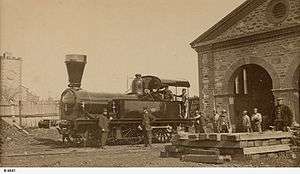Locomotives and rolling stock of the Victorian Railways, predecessors and successors |
|---|
Melbourne and Hobson's
Bay Railway Company | |
|---|
Geelong and Melbourne
Railway Company |
- Ariel - 0-4-0T (1855)
- Titania, Oberon, Typhoon and Sirocco - 2-2-2WT (1855)
- Hurricane and Cyclone - 2-4-0WT (1857)
- Goliath, Hercules, Smason and Tubal-Cain - 0-6-0WT (1855)
|
|---|
Melbourne and Suburban
Railway Company |
- Hawthorn and Richmond - 2-4-0T (1860)
- Kew and #1378 - 2-4-0WT (1861)
|
|---|
Melbourne
Railway Company |
- Windsor and Prahran - 2-4-0WT (1863)
|
|---|
Melbourne and Essendon
Railway Company | |
|---|
Melbourne and
Hobson's Bay United
Railway Company |
- Toorak, Victoria, No.16 and No.19 - 2-4-0T (1865)
- 4-4-0WT (1871), later C Class
- Pier Donkey No.24 - 0-4-0WT (1875)
|
|---|
Deniliquin and Moama
Railway Company | |
|---|
Victorian Railways
steam locomotives | |
|---|
| Diesel-electric | |
|---|
| Diesel-hydraulic | |
|---|
| Rail tractor | |
|---|
| Electric | |
|---|
| Railmotors |
- Steam - C, F, H150, J4 J6, N, Rowan and Kerr Stuart
- Gasoline - McKeen
- Petrol - AEC, Leyland, Brill, PERM and Trailers
- Diesel - DERM, Walkers, DRC, Sprinter, VLocity and Trailers
|
|---|
Road transferable
locomotives | |
|---|
Electric
passenger trains | |
|---|
Passenger
carriages by type | |
|---|
Passenger
carriages by class | | Joint and shared stock (SAR) | |
|---|
| Joint and shared stock (NSW timber) | |
|---|
| Joint and shared stock (NSW steel) | |
|---|
|
|---|
| Goods vehicles by type | |
|---|
| Goods vehicles by traffic | | Bitumen |
- OT, TW and TWF
- VTBA/F/X/Y
|
|---|
| Cement powder | |
|---|
| Fertiliser | |
|---|
| Flour, grain and rice |
- Flour: FX/FJ, FX/VPFX
- Grain: G, GY and GZ, G1, GH, GJX/F and VHGF/X/Y, VHAF, VHLY, VHKY and VHNY, VHHF/X/Y
- Rice: VHBF, VHRF/X, VQRF
|
|---|
| Livestock | |
|---|
| Mail and parcels | |
|---|
| Minerals and rocks | |
|---|
| Oil and petroleum |
- Safety wagons: VDSF, VKKF
- Alcohol: Unclassed
- Ammonia: Unclassed
- Coal fuel: CFT
- Gas: QGF/VQEY/F/X
- Kerosene: OT
- LPG: VTGX/Y
- Liquid chlorine: OT
- Hydrocarbon: TW and TWF, VTHA/X/Y
- Pintsch gas refuse: OT
- Tar: OT
- White spirits: VTQA/F/X/Y/Z
|
|---|
| Perishables | |
|---|
| Personal vehicles | |
|---|
| Steel |
- Electrical equipment: QB, QS, VFGA, VFHA, VFHF
- Cables: SX/SCX/VFFX, SE/SEF
- Slab steel: VKOX, VKEX, VKKX, VOEX
- Coiled steel: CSX/VFSX/VCSX, SLX, VOSX/VOVX/VCVX
|
|---|
| Timber |
- Logs: VFHX, VFTX (ex VLEX), VFTY/F/X
- Masonite: KM
- Scantling: KS, IS, IT
- Pineboard: FPX/VFMX
- Pulpwood: KPW, KT
- Woodchips: KW
|
|---|
| Other |
- Corpses: C/J
- Experimental: VQPW
- Explosives: P, NPH
- Paper: VFNX
|
|---|
|
|---|
| Guard's vans | | Exclusive guard's vans | |
|---|
| Partial guard's vans | |
|---|
| Power vans | |
|---|
|
|---|
| Departmental stock | | Ballast | |
|---|
| Locomotive PBC | |
|---|
| Locomotive sand | |
|---|
| Sleeper trains | |
|---|
| Weighbridge test | |
|---|
| Equipment | |
|---|
| Water |
- WT
- DW
- Former locomotive tenders
|
|---|
| Workshops and depot use |
- HD (way and works branch)
- HR (rolling stock branch)
|
|---|
| Workmen vehicles |
- Kitchens: WK/WM
- Showers: WS
- Sleepers: W, WW, WWW and WS
|
|---|
| Other | |
|---|
|
|---|
2 ft 6 in (762 mm)
Narrow gauge
locomotives and stock | |
|---|
Named or
significant trains | |
|---|
|

![]()